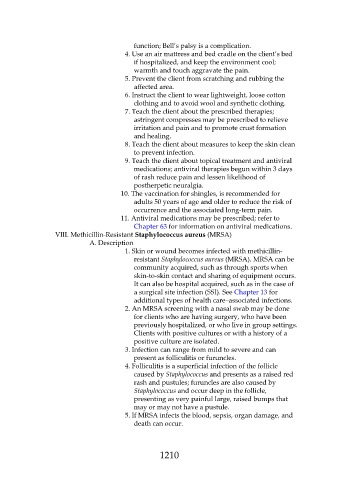Page 1210 - Saunders Comprehensive Review For NCLEX-RN
P. 1210
function; Bell’s palsy is a complication.
4. Use an air mattress and bed cradle on the client’s bed
if hospitalized, and keep the environment cool;
warmth and touch aggravate the pain.
5. Prevent the client from scratching and rubbing the
affected area.
6. Instruct the client to wear lightweight, loose cotton
clothing and to avoid wool and synthetic clothing.
7. Teach the client about the prescribed therapies;
astringent compresses may be prescribed to relieve
irritation and pain and to promote crust formation
and healing.
8. Teach the client about measures to keep the skin clean
to prevent infection.
9. Teach the client about topical treatment and antiviral
medications; antiviral therapies begun within 3 days
of rash reduce pain and lessen likelihood of
postherpetic neuralgia.
10. The vaccination for shingles, is recommended for
adults 50 years of age and older to reduce the risk of
occurrence and the associated long-term pain.
11. Antiviral medications may be prescribed; refer to
Chapter 63 for information on antiviral medications.
VIII. Methicillin-Resistant Staphylococcus aureus (MRSA)
A. Description
1. Skin or wound becomes infected with methicillin-
resistant Staphylococcus aureus (MRSA). MRSA can be
community acquired, such as through sports when
skin-to-skin contact and sharing of equipment occurs.
It can also be hospital acquired, such as in the case of
a surgical site infection (SSI). See Chapter 13 for
additional types of health care–associated infections.
2. An MRSA screening with a nasal swab may be done
for clients who are having surgery, who have been
previously hospitalized, or who live in group settings.
Clients with positive cultures or with a history of a
positive culture are isolated.
3. Infection can range from mild to severe and can
present as folliculitis or furuncles.
4. Folliculitis is a superficial infection of the follicle
caused by Staphylococcus and presents as a raised red
rash and pustules; furuncles are also caused by
Staphylococcus and occur deep in the follicle,
presenting as very painful large, raised bumps that
may or may not have a pustule.
5. If MRSA infects the blood, sepsis, organ damage, and
death can occur.
1210

